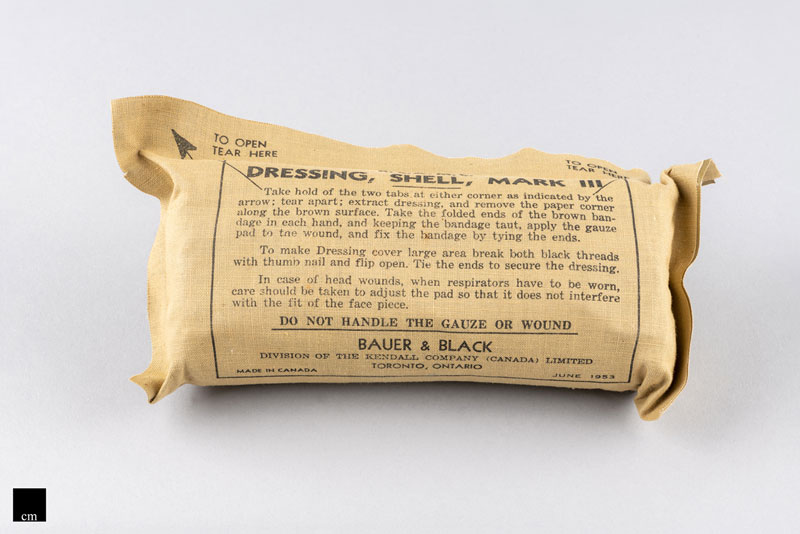The following 35 listings were found:

Analytical Balance
Two-pan analytical balance used to determine the mass of a drug or chemical. Manufacturer: Seederer- Kohlbusch Inc., New Jersey. DATE: 1940s. (Estimated year of manufacture pre-1945). A set of weights is included in the red box.

Bermingham Nasal Douche
A glass tube with the open end curved upward for placement in the nose and a fill spout on the top. Used for irrigating the nasal passages. Made in the USA. Distributed by E-Z Products, New York, NY. DATE: 1940s.

Breast Pump
Used to pump milk from a nursing mother. Description: Vintage flanged glass tip with extended port on the side and a rubber bulb securely attached at distal end. By hand holding the flanged end it fits over a breast and by squeezing the bulb there is a suction-release cycle thereby withdrawing milk from the breast. DATE: 1930s; DONATED: Margo Williams (VGH Nursing Graduate).

Chesley Artificial Leg Prosthesis
Used to help mobility after a leg amputation. Made by Charles Chesley of Hantsport, NS, of acrylic resin, carbon fiber, silicone thermoplastics, aluminum and titanium, with movable knee and ankle joints, leather top to lace tight once in place over the remaining thigh. DATE: 1917 -1950. Sent world-wide after WWI.

Courrand Core Biopsy Needle
Used to obtain a tissue sample. Reusable Becton-Dickson, #8 gauge, 4 inch long hollow shaft needle with trocar tip with a 4 and 1/2 inch stainless steel solid stylet with blunt end, extending beyond the needle, to obtain the tissue sample. DATE: 1920s -1970s; DONATED: Don Carruthers, Supervisor VGH Operating Room, VGH graduate class 1942.

Doctor's Travelling Instruments Kit
Used for transporting essential instruments. Content: syringe, injection needles, suture removal scissors, Kelly forceps, metal catheter, Keith needles for suturing, non-absorbable sutures, toothed tissue forceps, bandage scissors, probe and grooved director. Date: 1930s – 1940s.
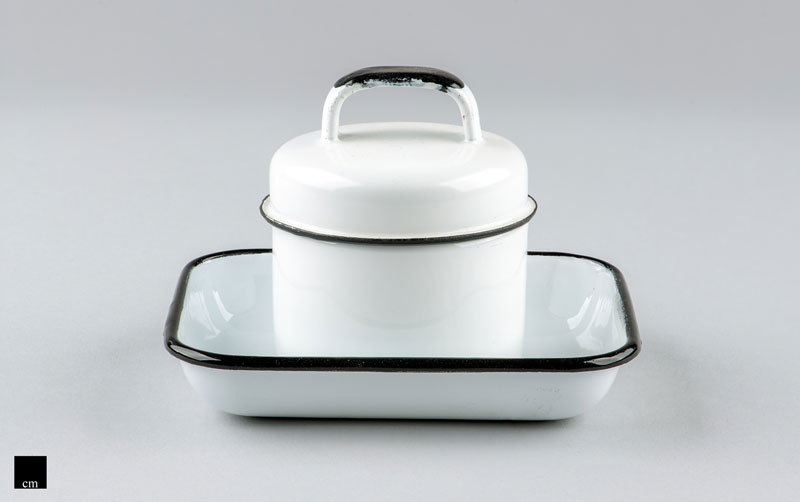
Enamel Soap Tray & Cotton Ball Container
Vintage white enamel blue trimmed soap tray & small round blue trimmed bowl with cover containing medical swabs. DATE: 1900s – 1930s; ACCESSION #: N52. 55.

Enema Apparatus
Used to administer an enema to a bed-restricted patient. Stainless steel pan for lubricant, thermometer, rectal tube, soap in wire container to make soap suds in the jug of luke-warm water, rubber tubing and clamp to control flow. DATE: 1950’s-1970’s.

Finger-tip 50 cc Glass Syringe, Plain Tip with Injection Needle attached
Date: 1900s; plain glass barrel and plunger, finger controlled.
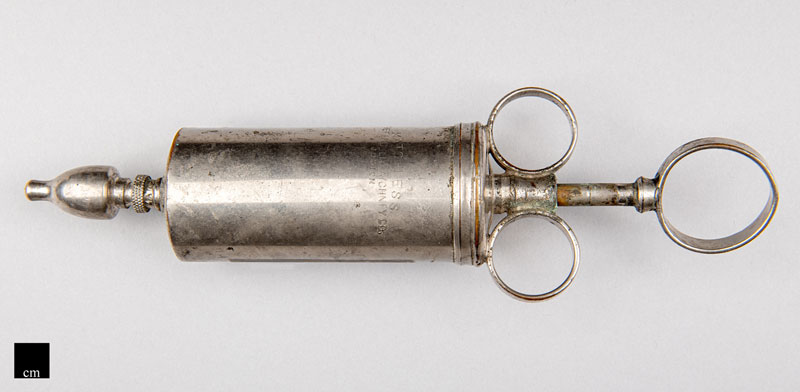
Finger-tip Metal 50 cc Toomey Syringe
Date: 1915; Reusable syringe with metal barrel and plunger and finger control when injecting.

First Heart Lung Bypass Machine Used in the Maritimes
Used to temporarily take over the function of the heart and lungs during surgery. DATE: 1956. To bypass the cardiopulmonary circulation, catheters are placed in the inferior and superior vena cava. These direct venous blood to a venous reservoir, heat exchanger, oxygenator and roller pump. The roller pump propels arterialized blood through the filter and bubble trap. The blood then is returned to the patient through a catheter in the femoral artery.

First Kidney Dialysis Machine in the Maritimes
Used to remove unwanted waste products from blood and balance electrolytes and minerals. DATE: 1969; Parts: tubing, arterial and venous pressure monitors, blood pump, heparin pump, dialyzer inflow pressure monitor, dialyzer, air trap & detector, air tubing clamps.

Gas Machine
Used to deliver a mixture of gas and oxygen to a patient during surgery. Date: 1915. First machine as a closed circuit to reuse the exhaled gas. D.E. Jackson model: on the frame, four Rotamers with valves measuring the flow of each gas; carbon dioxide absorber canister filled with a solution of sodium hydrate, calcium hydrate or soda lime; three pressure regulators connected to tanks – 2 oxygen, one nitrous oxide and one cyclopropane: corrugated black small rubber tubing from the machine to a rubber balloon, squeezed by the anaesthetist to administer a mixture of gas and oxygen, keeping the patient asleep and pain free during surgery.

Hypo Injection Tray
DATE: 1920s - 1950s; Tray contents: 2 cc acid-etched calibrated reusable syringe and hypodermic needle; vial containing Pantopon analgesic pill (opium alkaloids), box of matches, tablespoon with a cork at the end to create a balanced spoon, emery block to sharpen needle after each use, a Bunsen burner, container for swabs, alcohol. Pantopon placed in measured water in the spoon, held over flame, timed for 2 minutes as pill dissolved, with syringe and needle attached (which has been sterilized by boiling in water for 3 minutes and removed with sterile forceps which were soaking in alcohol in a metal container) pull up medication, inject into patient’s upper arm.

Hypodermic Plain Syringe
Date: 1925. Reusable plain 2 cc glass barrel & plunger hypodermic syringe, several Becton-Dickinson reusable hypo needles. Both cleaned after use in a special solution & flushing out the needle, tip checked for bur and removed by using a whetstone, double wrapped and steam-sterilized in an autoclave.

Luer-Lock Syringe and Insulin Syringe
Luer-Lock Syringe (top): Luer-lock tip, graduated glass syringe to accurately control medication, with special tip to secure the needle, a plunger, the number on the barrel and plunger making a proper match – for safety and proper functioning of the syringe. DATE: 1925 -1960s.
Insulin Syringe (lower): a graduated glass barrel for accurate measure, blue plunger enables visual accuracy for the correct amount of insulin, hypodermic needle for the injection of medication into the patient. Both syringes are reusable and must be cleaned, specially wrapped for sterilizing. DATE: 1925 -1960s.

Male Urinal with Cloth Cover & 1898 Ironstone Bedpan
Male Urinal 1920 – 1940s, made of white enamel. Porcelain & ironstone bedpans used in the early 19th century; marking on this bedpan: ‘EUREKA’; patented March 12, 1889; trade mark - Registered’. Urinals and bedpans were stored, emptied and cleaned in a small room - ‘Utility Room’.
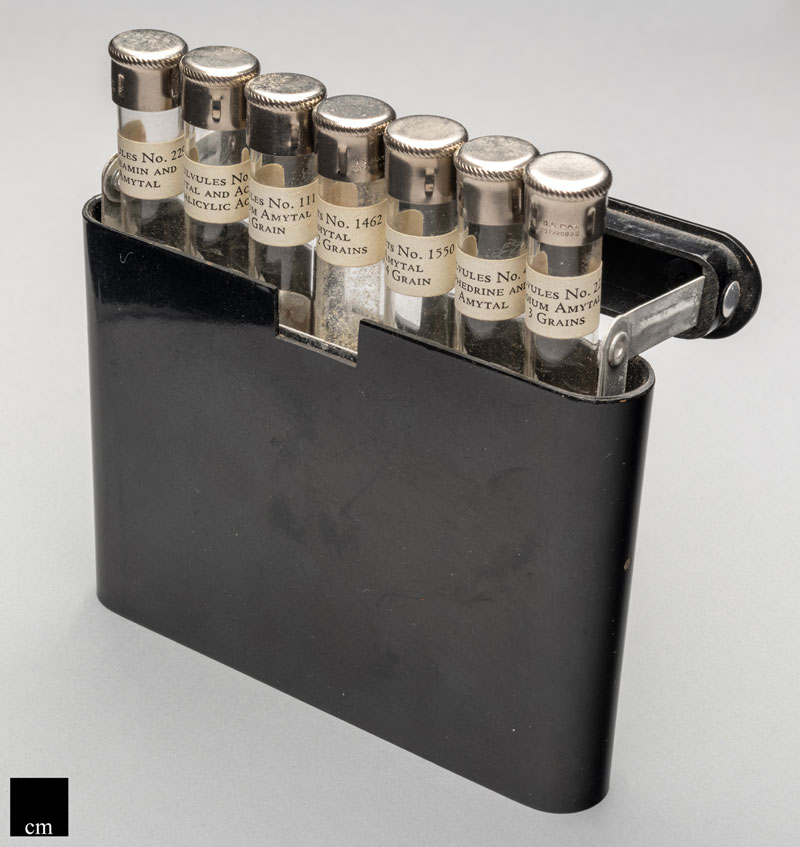
Medication Vials in a Pocket Carrying Case
Pocket case with vials containing medication used for sedation and pain relief (Case and vials made by Eli Lilly Company). Date: 1920s.
Contents: PULVULES #229 - Thiamin & Amytal; #33 - Amytal & Acetylsalicylic Acid; #11 - Sodium Amytal 1grain; TABLETS #1462 - Amytal 11/2 grains; #1550 - Amytal ¾ grains; PULVULES: #44 - Ephedrine & Amytal; #222 -Sodium Amytal 3 grains.
Pulvules – Eli Lilly’s brand of gelatin capsules. ACCESSION #P2.

Medicine Cup & Nose Irrigating Cup
Left- medication cup used for measuring and administering liquid medications.
Right - nose cup for douching the nose (McKesson and Robbins) (early 1900s); Measurement markings in ounces and in drams.

Medicine Cup and Eye Dropper
Dropper used to administer medication to the eye. Medication cup has measurement markings in cubic centimeters (30 cc) and ounces (1 oz). Date: 1940s – 1950s; ACCESSION # N30.

Microscopes
DATE: 1950 – 1970.
Small compound microscopes by E. Leitz of Wetzlar about 1880. Horseshoe is of brass, rotatable concave mirror, the back surface is plain and blackened. Fixed rectangular stage with diaphragm disk. Used by Dr. Ronald Martin in the MacKenzie Laboratory in 1966, under direction of Dr Van Rooyen, a distinguished scientist. Martin also taught Bacteriology in the Faculties of Medicine and Dentistry at Dalhousie University. As a member of the “International Physicians for the Prevention of Nuclear War” Martin received the Nobel Peace Prize in 1985. He continued with his research at Dalhousie University until 1999. Donated by Dr. Ron Martin.
The black microscope, second from left, was used in teaching nurses at the Victoria General School of Nursing and donated by Jean McGee RN, Director of Nursing Victoria General Hospital.

Nurse's Travel Hypodermic Syringe Kit
Date: 1890. Small metal case containing four reusable hypodermic needles and metal 2cc syringe. Before use the needle and syringe would be sterilized by boiling in water for 5 minutes, on a stove in the patient’s home, and removed by forceps to use. ACCESSION: N45.

Nurse's Travel Instrument Set
Black leather case containing: probe-ligature carrier, suture scissors, injection needles, 2 cc graduated glass syringe, long metal probe, metal catheter and 2 different tipped tissue forceps. Owned by Irene Mallish, VGH nursing graduate class 1942 & donated by Faye Hergett, VGH nursing class 1960B. Date: 1940s; ACCESSION #: N40.

Nurses Travel Syringe Set
DATE: 1900s; small metal case, 4 reusable injection needles, 2 cc glass reusable syringe (barrel and plunger). ACCESSION #N45.

Oxygenor King (Quack Medical Device)
Quack medical device used to increase oxygen absorption in the blood. DATE: 1911. Silver metal cylinder with five ports. Green, black and red fabric cords attached. Engraved: Oxygenor King, Price $35.00. Canada Oxygen Company Limited, Halifax.
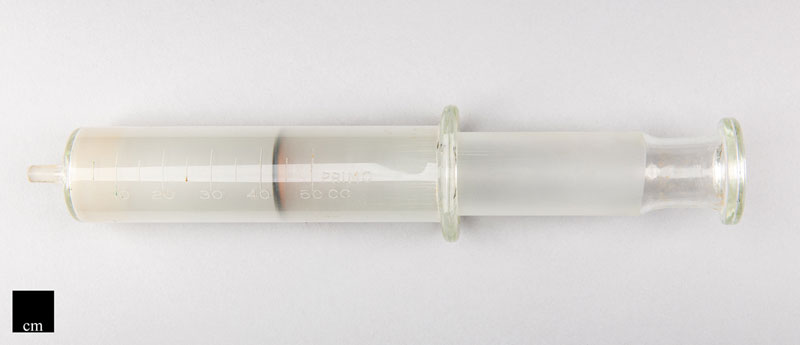
Plain Glass Toomey Syringe
Date: 1940s. Robert Lucas & William Chance invented the all glass syringe which included a barrel and plunger with a plain tip.

Sphygmomanometer
Used to determine blood pressure. Portable manual mercury manometer in a metal case and inflatable cuff, a manually operated bulb with a control valve. Date: 1950s, Vintage.

Surgical Needles
Used for closing an incision. Ethicon(483) disposable sterile packaged atraumatic stainless steel curved cutting edge Retention Needle with swaged #3 non-absorbable black silk suture material for closing the skin & used with a Needle Driver. Ethicon (5623) disposable sterile package with Keith needle and swaged 2-0 Nurolon non-absorbable suture for sewing skin edges together & used by hand & tissue forceps to hold skin edges together. Two reusable Keith needles with eye to thread a suture material. DATE: vintage 1900s; ACCESSION #: G28.

Surgical Wire Suture Material
DATE: 1920s – 1970s; wire suture of various gauges and selected according to the bone size or specific purpose, in order to use a trocar, drill and pliers are available to pull the wire through a drilled bone hole or through a trocar, the pliers may also be used to twist the wire tighter; wire then cut with special wire scissors and wire tips turned inward by using pliers to prevent skin injury.

Urology Bladder Irrigation Apparatus
Two metal Toomey syringes with metal tip adapter to insert into a catheter to irrigate the bladder; urology water taps, variety needle sizes to inject medication relieving discomfort and pain. Used for continuous drainage of the bladder in surgery or post-operative. Date: 1920; ACCESSION # M91.

VGH Embossed Emblem China, Utensils and Serving Pieces
Gold trimmed, permanent underglaze colour china, the ‘Trentham Rose’ – Madock, England. Used 1948 – 1967 for ‘private patients’ on floors 9, 10 and 11 in the Victoria General Hospital building which opened in 1948. At the time, the hospital was the tallest one in Canada. Now referred to as the Victoria Building.

Victoria General Hospital (VGH) Nursing caps and Florence Nightingale Lamp
Nursing cap (left) – worn by graduate nurses 1900 - 1931; Nursing cap (right) – worn by graduate nurses. It was the first cap used when the VGH School of Nursing began in 1890; Nursing cap (front) – worn by Registered Nurses (RN) 1931 onwards. The VGH School of Nursing closed in 1995.
Lamp - This is known as the Florence Nightingale lamp and was significantly used at the “Capping & Candle Lighting" ceremony. This ceremony occurred after successfully passing the probationary exams and was introduced by the Director of Nursing, Maisie Miller, in 1940 and was discontinued in 1966.
The cap, given to each nurse was a plain white cap, and as the candles were lit, the nurses said in unison the Florence Nightingale Pledge. As well, a small white Bible was presented and both of these items the nurse was able to keep.

Wafer Paper & Glass Conical Pharmaceutical Graduate
WAFER PAPER (Papier de Riz) made by Mace & Haldane - round thin rice paper used for administering bad-tasting medication that could cause patients to vomit. Medication as a powder, bolus or pill was folded in a sheet of rice paper. The folded rice paper was dipped in water to soften it prior to giving it to the patient to swallow. DATE: Mid to late 1800s. ACCESSION # P1.
CONICAL GRADUATE: Used to measure a small volume of liquid up to a maximum 2 fluid drams or 120 Minims (approximate equivalency 1 fluid dram = 5ml).





